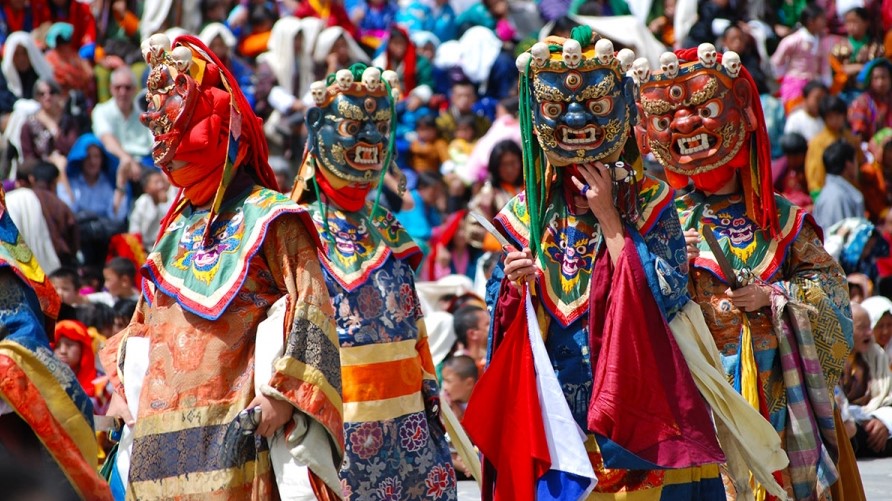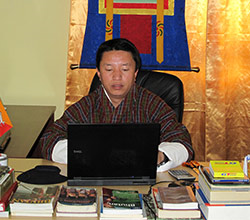The Domkhar Festival is a vibrant cultural and spiritual celebration held annually in Domkhar village, located in the picturesque Bumthang district of Bhutan. This three-day festival is hosted at Domkhar Tashicholing Lhakhang, a revered temple with a rich history tied to Bhutanese Buddhism. The festival typically occurs in the spring, drawing both locals and visitors to partake in its unique blend of spirituality, tradition, and community joy.
At the heart of the Domkhar Festival are the mesmerizing cham dances performed by monks and local lay dancers. These sacred dances, accompanied by traditional music, narrate Buddhist teachings, legends, and the triumph of good over evil. Each dance is deeply symbolic, aiming to purify the attendees’ minds, ward off negative energies, and bring blessings for prosperity and happiness. Highlights include the Guru Tshengye cham, which honors Guru Rinpoche, and other dances showcasing Bhutan’s spiritual heritage.
Beyond the spiritual dimension, the festival is a colorful social event. Locals dress in their finest traditional attire, creating a vibrant atmosphere filled with laughter, chatter, and unity. Stalls offering conventional Bhutanese cuisine, handicrafts, and games add to the festive charm. For visitors, it’s a chance to immerse in Bhutan’s unique cultural essence, witness centuries-old traditions, and experience the warmth of the local community.
The Domkhar Festival is not just a religious celebration but a living expression of Bhutan’s harmonious blend of spirituality, culture, and social life, making it a truly unforgettable experience.
Festival provides the occasions for the community to get together
By witnessing the festivals, our sins are removed and blessed with virtues and merits.
Family members are gathered together during the festivals.
Explore how these religious dances convey religious messages to the people.
Discover how it brings joy and happiness to all sentient beings.
It is also a time, where the Bhutanese will dress up with their finest traditional dresses.
Festivals play a very important role in the essence of Bhutanese culture.
Festivals are combination of both the spiritual and social.
Festival teaches the basic precepts of Buddhism to the people.
Mingle and be like local and happy people of Bhutan.
Explore, Discover and enjoy the religious festivals held in the Himalayan Kingdom of Bhutan.
Day 01. Arrive to Bhutan – Transfer to Thimphu
The flight into Paro on our national carrier, Druk Air, is a befitting introduction to the spectacular beauty of our country. In clear weather, magnificent views of the world’s highest peaks like Gangkar Puensum, give way to the lush green Paro valley as you land. Your Bhutanese escort from Authentic Bhutan Tours- For Your Bhutan Experience! will warmly welcome & greet you on arrival, and then to Thimphu, the capital city of Bhutan. The drive will take about 1 hour and 30 minutes along a river valley, past small villages and traditional farmhouses, through peaceful countryside. It’s a small & charming capital city located in the heart of the Himalayas.
On reaching Thimphu, we will do a short hike, from Kuensel Phodrang to Depsi (South of Thimphu). Before we start the hike, we will visit to Tallest Buddha Statue in the world. Then we will start the hike. The hiking is more or less very easy and plain walk through the forest of Pine, Rhododendron and Oak trees. The hike will take about 1-hour 30 mins. We can see Thimphu city, Thimphu River (Wangchhu) and other adjacent towns through this hike. We can also take some fluttering prayer flags (Lungta) and hang them between two to three trees that will bring fortune, happiness and good health to every one in this world including your enemy.
Evening visit Tashi Chho Dzong, seat of the national government and the Central Monastic Body, including the summer residence of the Je Khenpo (Chief Abbot of Bhutan) and stroll around Thimphu town. Dinner and overnight stay in the hotel, Thimphu
Meal Plan: Welcome Dinner Accommodation: Hotel
Day 02. Thimphu stay
Sightseeing in Thimphu, visit to Memorial Chhorten, built in 1974 in the memory of third king late Jigme Dorji Wangchuk, and the temple inside gives good examples of tantric Buddhist and its philosophy. Mothithang minizoo to see the National Animal of Bhutan (Takin), Zulikha Nunnery, the Thangtong Dewachen nunnery was founded in 1976 by Rikey Jadrel and today it houses the sixty nuns engaged in Buddhist study and practices. Folk Heritage Museum, this Folk Heritage Museum is a showcase, the 19-century farmhouse and the living style of the Bhutanese family. National Library, the National Library was established in 1967 to preserve many ancient Dzongkha and Tibetan texts. Lunch in Thimphu town.
After lunch, visit Paper Factory, were Bhutanese Traditional Papers & paper products are made. Weaving Center produces hand-woven textiles on site and has a selection of cloth and ready-made garments for sale. This is one of the few places where you can watch weavers at work, and then Authentic Bhutanese handicrafts.
Evening we will visit Bhutanese Farm House for dinner and Traditional Hot Stone bath. Over night stay at Thimphu Hotel or we can organize even in Bhutanese Farm House.
Accommodation: Hotel
Day 03. Thimphu – Punakha /Wangdi
After our breakfast, we will drive to Punakha/Wangdi. The road climbs steeply through forests of pine, hemlock spruce and rhododendrons. At Dochula Pass (3150m) you will have a breathtaking panoramic view of the Eastern Himalayan Mountain ranges. The pass is adorned with 108 small stupas and many kinds of prayer flags. Then the road descends through lush forests to the fertile valley of Punakha & Wangdi Pghodrang.
On reaching Lobesa, we will visit Chhimi Lhakhang, which is located at a hilltop. The temple is known as ‘the temple of fertility’. At Punakha, visit the most beautiful dzongs in Bhutan, Punakha Dzong. After this, we will drive till the view point of Khamsum Yule Namgyle Chhorten, passing the beautiful rural landscape.
Evening at leisure. Dinner and over night stay at Hotel Punakha/Wangdi
Accommodation: Hotel
Day 04. Punakha/Wangdi – Bumthang
After the breakfast, we will drive to Bumthang, the central Bhutan. The road will slowly ascend until Pelela pass (3400m). You may spot a yaks grazing along the roadside by Pele la Pass. The road descends through semi-tropical vegetation and alpine environment, with rhododendron trees and dark green dwarf bamboo. Your lunch will be served at Rukubji Restaurants. You will stop by at Chendebji Chhorten, the chorten is patterned after Swayambhunath in Kathmandu and was built in 19th century to cover the remains of an evil spirit that was killed at this spot. As you enter Trongsa valley, the huge fortress of Trongsa Dzong, the most impressive dzong in Bhutan appears on the far side of a deep valley.
On reaching Trongsa, we will visit Trongsa Dzong and the ‘The Tower of Trongsa’ – Religion and Power in Bhutan. The Tower of Trongsa is a museum in which aspects of Bhutanese culture and history are explained by beautifully objects, while for others it is as scared place of encounter with the gods. Then we continue our journey to Bumthang, through the hairpin bends with the dense forest of rhododendron, conifers, alder and oak crossing Yotong La, 3425m. The road then comes out into a wide-open cultivated valley – which is the Chumey Valley, the first of Bumthnag’s four valleys. From here the road goes on straight until we see Jakar Dzong and then drops into bends before straightening out again in the main valley at Chamkhar. At Chhumey, we will Chumey Yathra Production center (Yathra – Woolen Textile).
Evening at leisure. Dinner and over night stay at hotel Bumthang. Mepham Guest house or similar standard.
Accommodation: Hotel
Day 05. Bumthang Stay
Enjoy wit Domkhar Festival in Bumthang.
Accommodation: Hotel
Day 06. Bumthang Stay
You can go to the festival today also or sightseeing in Bumthang valley like visit to Jambay Lhakhang, which is one of the oldest temples in Bhutan, built in 7th century, Kurjey Lhakhang, is named after the body print of Guru Rinpoche which is preserved in a cave inside the oldest of the three buildings, Tamshing Lhakhang – which was established by Terton Pema Lingpa in 1501 and is the most important Nyingma Goenba in the country. Lunch in the Bumthang hotel.
After lunch we will visit Mebertsho (Burning Lake) – This is a very scared lake for Bhutanese people. Terton Pema Lingpa discovered several of Guru Rinpoche’s hidden religious treasures from this lake.
Evening we will visit to Farmer’s House for Bhutanese Tea, Alcohol and Hot Stone Bath (Dhotsho). We can also organize over night stay in Farm House. Dinner and overnight stay at hotel, Bumthang or Farmer’s House.
Accommodation: Hotel
Day 07. Bumthang – Paro (domestic flight).
After our early breakfast, we will transfer to Bumthang Airport and fly to Paro. After reaching Paro, we will hike to Paro Taktshang Monastery till the viewpoint. On our way back, we will visit to Kyichu Lhakhang, the oldest monastery in Bhutan.
Evening stroll around Paro town. Dinner and overnight stay at hotel Paro. Hotel Dewachen Resort or similar standard.
Accommodation: Hotel
Day 08. Paro – Paro International Airport
After our breakfast, we will drive to Paro International Airport for your onward flight. Our guide and driver will bid you farewell here at the airport. We wish you a very safe and pleasant flight for your onward destinations.
Start planning your tailor-made Dream Holiday to Bhutan – The Land of happiness!
In order to experience the best and rewarding fulfillment clients must plan in advance the different logistics that you have in your minds before actually venturing into the world of trips. You might have wishes and hopes for which you need to plan.
The following information will help you to plan your dream trip to Bhutan.
1. When and how to visit Bhutan?
Choose your traveling date like Arrival/Departure date. You also need to choose entry/depart Bhutan via AIR or LAND.
By Air: Druk Air, the national carriers is the only service operator in the kingdom and operates several flights per week from Bangkok (Thailand), Delhi & Kolkata (India) and Kathmandu (Nepal) to Paro (Bhutan). The Paro International Airport is located about an hour and a half drive from Thimphu, the capital city of Bhutan.
Paro airport is daylight restricted, and the flights are totally dependent on the weather. As a result, sometimes flights are delayed. It is therefore a good idea to keep at least 24 hours of transit time for connecting flights out of Paro. You might also want to consider traveling on a non-restricted ticket so that if you miss a connecting flight, you can be rerouted or seated on the first available carrier.
Sometimes flights into Paro are disrupted because of unfavorable weather conditions. If this occurs, the flight will stop for the night at the transit airport. To be prepared, you may want to carry your essential personal items in your carry-on luggage.
By Land: Phuentsholing, a Bhutanese town in the southwest has road access to India. It is located about 170 km from the Indian domestic airport at Bagdogra, West Bengal. Phuentsholing is about 172 km from Thimphu the capital city of Bhutan and is about 6hours drive distance. And S/
2. What are your itineraries?
All the tours can be customized and extended as per our valued client’s requirements. There are sample itineraries for your kind reference and it will give you some general idea of the likely trip scheduled.
Complete the tour request form and submit it to us. Send us correct name list. We will send you the flight reservation status via email.
After confirming your reservation, we need the scanned copy of member’s passport.
Please remit us full payments and send us the copy of remittance paper via email. Visa will not be accepted without full payment.
We will send you the flight ticket copy and Visa Clearance Copy prior to your departure to Bhutan via email. You need to print out and carry along with you.
Start packing and looking forward to have a memorable trip in the LandThunder Dragon, DrukYul.
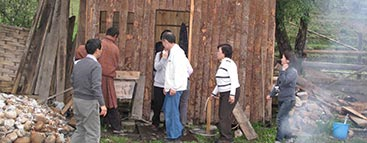
Hot stone bath (Dhotsho) is a traditional bath of Bhutan, where a tradition of heating up stones and then soaking in the water that is in turn heated by the stones. This is also a curative method and is used throughout the country We Bhutanese belief that this bath has so much of medicinal benefits. Some diseases are curable-like joint pains, hypertension, stomach disorder, arthritis and many other minor diseases. Especially for the old age, where we have lots of body pains, joints pains helps a lot by this Hot Stone Bath (Dhotsho).
I think, the minerals in the rocks have certain chemicals, which can cure certain disease of our body. Hot stone bath has no side effects. It is in its pure natural form. We can organize the hot stone bath during your stay in Bhutan.
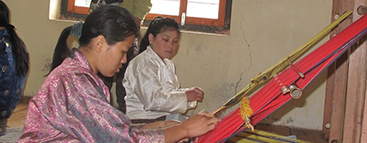
The Bhutanese textiles are rich, vibrant, and colorful and are a complex art form as well as an integral part of the Bhutanese culture. This Bhutan weaving experiences will give you an insight about the rich textiles in Bhutan. You can sit one of the handlooms of Bhutan and weave your self practically. We promise that you will really enjoy this with great satisfaction in your life.
We will also see or learn the natural coloring and dyeing. You can bring your own materials like handkerchief to dye and color. So visit Bhutan and experience it practically by yourself.
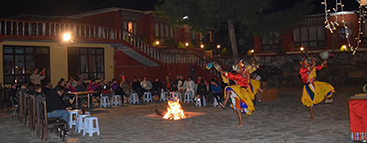
Folk Performing Arts & Music in the Himalayan Kingdom of Bhutan
We have Cultural Program Performing groups, which they will perform like Traditional folk songs, dances and keeps original tunes and dances alive. Moreover, new choreography for some traditional and regional songs is sometimes developed.
The troupe also performs mask dances that have historical and spiritual significance.
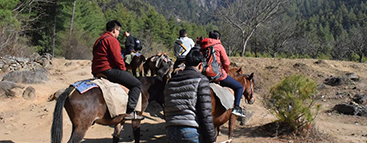
Tiger’s Nest is most visited spot in Bhutan and it is much awaited by every tourist who visits Bhutan to climb to Tiger’s Nest.
It takes about 2 hrs 30mins up steep climb through the forest of pine, oak and Rhododendron. However you can ride the horse and climb till the Taktshang cafeteria.


